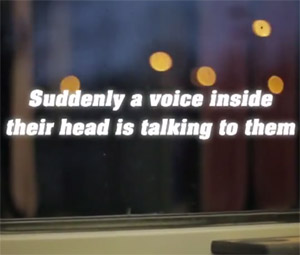 NEWS
NEWS
 NEWS
NEWS
 NEWS
NEWS
![]() Here’s a direction I didn’t quite expect bone-conduction audio to go—that is, a technology that enables audio devices to use human bones as resonators to play sounds (this technology would be good for hearing aids, and low-noise audio devices that are not “in ear.”) But, being able to put your head to a glass pane and listen to some soothing music would be nice; however, if train passengers in the UK suddenly start “hearing voices,” I mean advertisements, in their heads when they sleepily lean against windows that might backfire.
Here’s a direction I didn’t quite expect bone-conduction audio to go—that is, a technology that enables audio devices to use human bones as resonators to play sounds (this technology would be good for hearing aids, and low-noise audio devices that are not “in ear.”) But, being able to put your head to a glass pane and listen to some soothing music would be nice; however, if train passengers in the UK suddenly start “hearing voices,” I mean advertisements, in their heads when they sleepily lean against windows that might backfire.
The idea is simple: high frequency vibrations are propagated through a rigid surface, a person places their head against that surface, and their skull picks up and resonates those vibrations to the inner-ear, viola sound is heard. Noting that tired train and bus passengers often sit at a window seat and then lean their head against a window (a rigid surface) engineers at Sky Deutschland thought they could take advantage of this.
A video for the Talking Window campaign states: “Tired commuters often rest their heads against windows. Suddenly a voice inside their head is talking to them. No one else can hear this message.”
Fortunately, that using this only for advertising isn’t the point of this campaign and they’re socially conscious enough to understand that passengers might take offense:
“Some people don’t like advertising in general. But this is really a new technology. [It might] not only be used for advertising, but also for music, entertainment, mass transport information, weather reports and so on.”
The transmitter while Sky-branded will be made by Audiva—an engineering outfit centered around hearing assistance products.
I for one see a weird niche market for caps with vibration-absorbing padded rings
If my train, plane, or bus window started talking at me—or even playing music I couldn’t stand—I’d probably start using a blanket or a piece of insulating foam between my head and the window. I’m sure a few well-intentioned materials science engineers could even come up with a cap or a headband that would stop these sort of shenanigans. (Or learn to use a neck pillow?)
Now, if I had my own window and the ability to control what was being played on it (and advertisements popped up like I was listening to Pandora or Spotify) I don’t think that I’d be half-as-annoyed.
Sky Deutschland has an interesting idea, but this advertisement scheme is hardly socially conscious of the user experience end of the scheme.
Sky might be better served by offering something that adds value to the window or just let the people sleep.
Support our mission to keep content open and free by engaging with theCUBE community. Join theCUBE’s Alumni Trust Network, where technology leaders connect, share intelligence and create opportunities.
Founded by tech visionaries John Furrier and Dave Vellante, SiliconANGLE Media has built a dynamic ecosystem of industry-leading digital media brands that reach 15+ million elite tech professionals. Our new proprietary theCUBE AI Video Cloud is breaking ground in audience interaction, leveraging theCUBEai.com neural network to help technology companies make data-driven decisions and stay at the forefront of industry conversations.